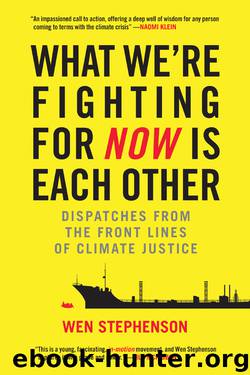What We're Fighting for Now Is Each Other by Wen Stephenson

Author:Wen Stephenson [Stephenson, Wen]
Language: eng
Format: epub
ISBN: 978-0-8070-8841-8
Publisher: Beacon Press
Published: 2015-03-03T16:00:00+00:00
By the time that two-hundred-pound anchor was hauled up from the channel bottom by a salvage crane, as the sun went down behind the plant, Ken and Jay had managed to block, for a day, the delivery of those forty thousand tons of coal.
When I told Ken that the action at Brayton Point reminded me of something Greenpeace might have done, back in the day, he just smiled: “Yep.”
In fact, if that image of a lobster boat blocking a coal freighter called anything to mind, for me it was the classic Greenpeace footage, shot in the Pacific waters off the coast of California in June 1975, in which a small band of committed souls in Zodiac inflatables positioned themselves between Russian whaling ships and a fleeing pod of sperm whales. Those iconic images—small boats against a massive industrial force, courageous individuals putting their bodies on the line in a quasi-mythic David-versus-Goliath tableau—exploded into popular consciousness like a “mind bomb,” to use the favorite phrase of counterculture journalist and Greenpeace cofounder Bob Hunter, who was one of those in the Zodiacs.
And yet those grainy frames of longhaired environmentalists saving whales can be somewhat misleading. When you look into the deeper origins of Greenpeace, as historian Frank Zelko notes in Make It a Green Peace! The Rise of Counterculture Environmentalism (2013), the combination of “green” and “peace” in the group’s name was meant to carry real significance. Nevertheless, Zelko observes, just as we put the emphasis on the first syllable of the name, so the “peace” half tended to be overshadowed as Greenpeace went on to become the world’s most recognizable environmental organization.
But “peace” wasn’t always the junior partner. Quite the opposite. Some of those most instrumental in the formation of Greenpeace in the early 1970s in Vancouver, British Columbia, had been deeply involved in the American Quaker peace and antinuclear movements of the fifties and early sixties. Indeed, the Quaker and Quaker-inspired pacifist voyages of the sailboats Golden Rule and Phoenix, protesting US nuclear tests near the Marshall Islands in 1958, were forerunners of the early Greenpeace boats, which ventured into the Pacific nuclear testing zones between 1971 and 1974. Greenpeace cofounders Irving and Dorothy Stowe and Jim and Marie Bohlen, heavily influenced by the Quaker practice of “bearing witness” and the emphasis on nonviolent resistance, inspired by Gandhian satyagraha, left a lasting imprint on the group.
Despite the media infatuation with the radical hippie ecology of Hunter and others, for these Quaker-influenced cofounders, saving humanity from itself was just as important as saving whales, seals, or any other species. And whatever tendency there may have been toward a holistic mysticism among the counterculture greens, those elder peace-movement veterans viewed their antinuclear protests, rooted in both science and moral conviction, as sober and eminently rational affairs.
Canadian journalist and Greenpeace cofounder Ben Metcalfe may have captured that founding spirit best. “We do not consider ourselves to be radicals,” he wrote for a radio broadcast aboard the very first boat called Greenpeace, in September
Download
This site does not store any files on its server. We only index and link to content provided by other sites. Please contact the content providers to delete copyright contents if any and email us, we'll remove relevant links or contents immediately.
Man-made Catastrophes and Risk Information Concealment by Dmitry Chernov & Didier Sornette(5958)
The Revenge of Geography: What the Map Tells Us About Coming Conflicts and the Battle Against Fate by Kaplan Robert D(4053)
Zero Waste Home by Bea Johnson(3809)
COSMOS by Carl Sagan(3593)
Good by S. Walden(3523)
In a Sunburned Country by Bill Bryson(3509)
The Fate of Rome: Climate, Disease, and the End of an Empire (The Princeton History of the Ancient World) by Kyle Harper(3035)
A Wilder Time by William E. Glassley(2838)
Camino Island by John Grisham(2781)
Organic Mushroom Farming and Mycoremediation by Tradd Cotter(2662)
The Ogre by Doug Scott(2659)
Human Dynamics Research in Smart and Connected Communities by Shih-Lung Shaw & Daniel Sui(2479)
Energy Myths and Realities by Vaclav Smil(2464)
The Traveler's Gift by Andy Andrews(2438)
9781803241661-PYTHON FOR ARCGIS PRO by Unknown(2343)
Inside the Middle East by Avi Melamed(2332)
Birds of New Guinea by Pratt Thane K.; Beehler Bruce M.; Anderton John C(2239)
A History of Warfare by John Keegan(2216)
And the Band Played On by Randy Shilts(2169)
